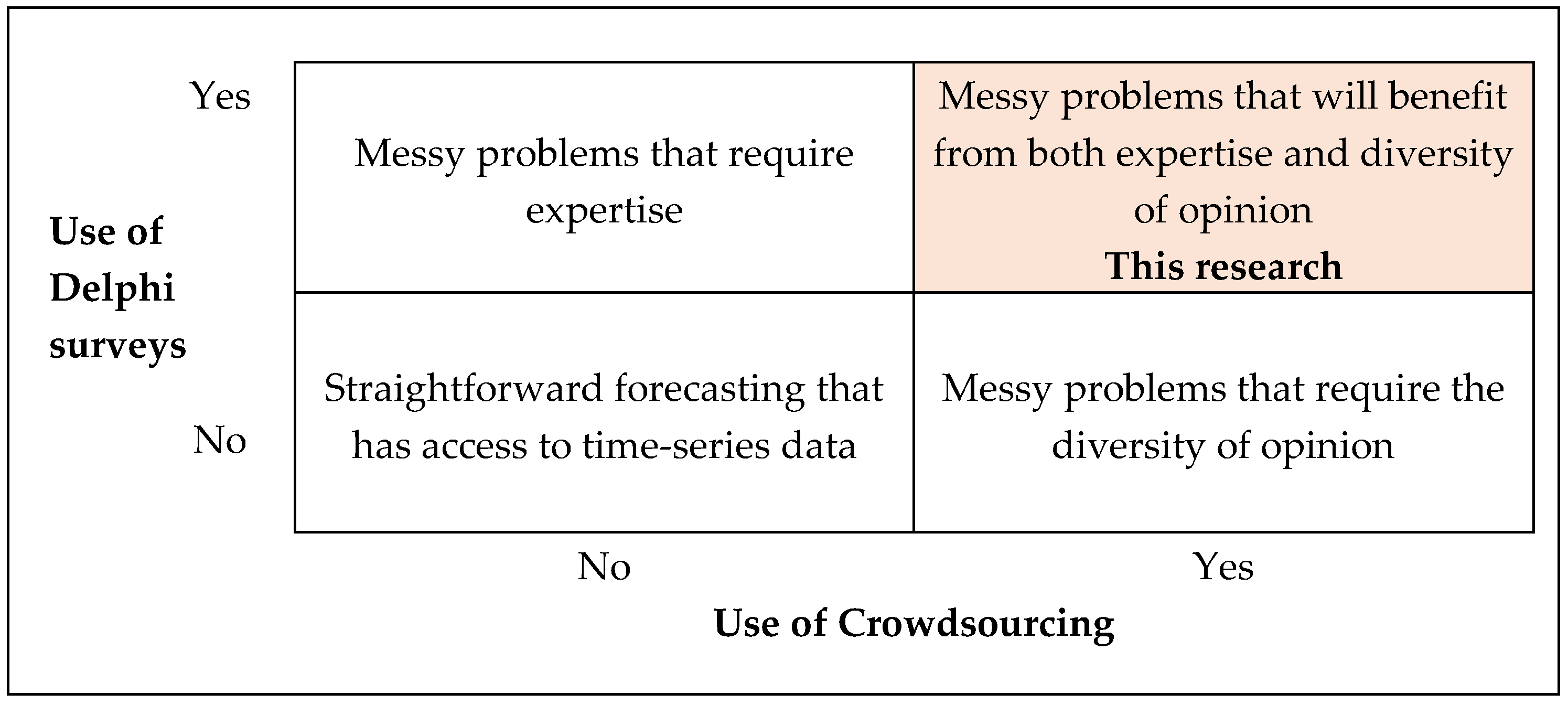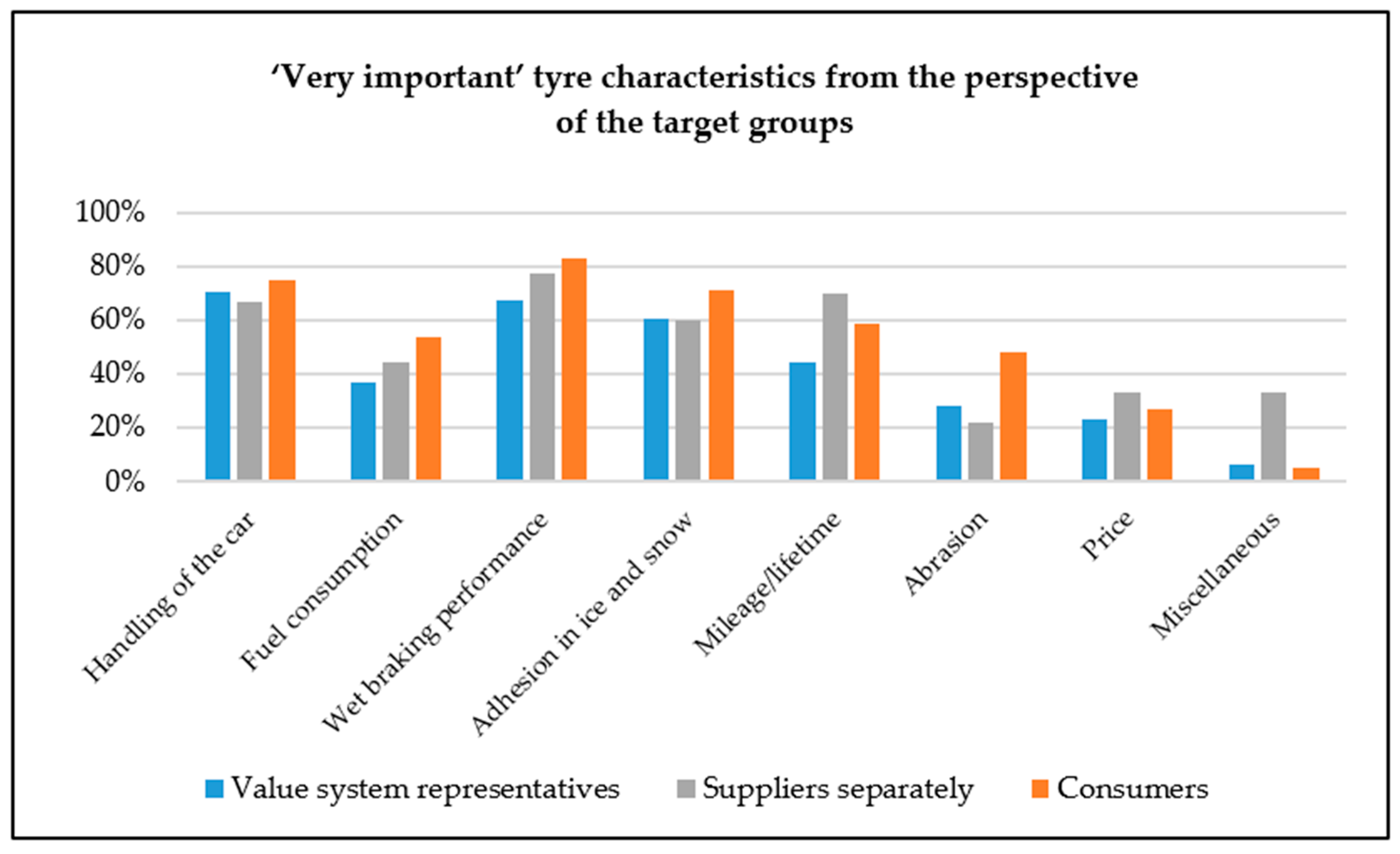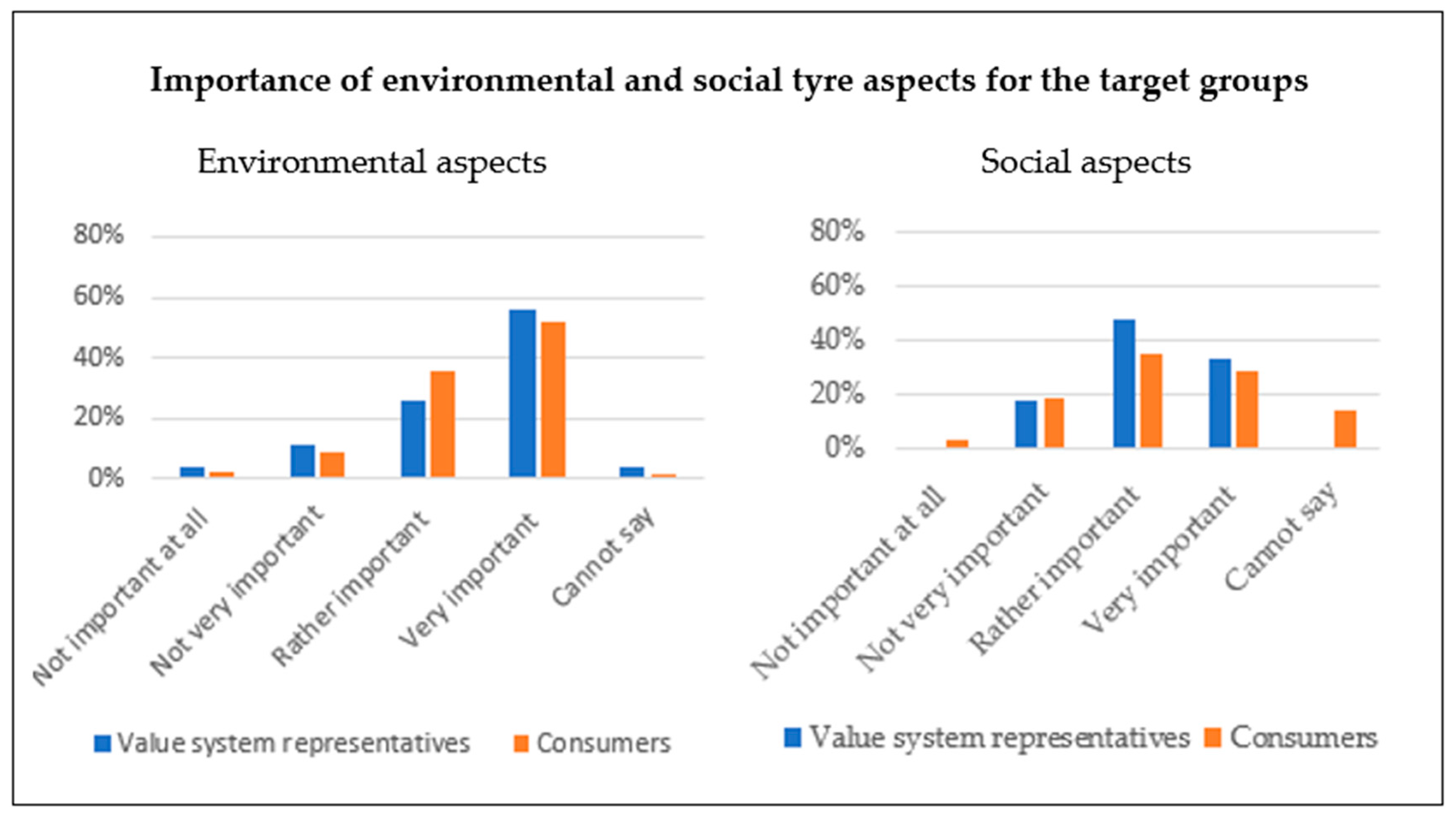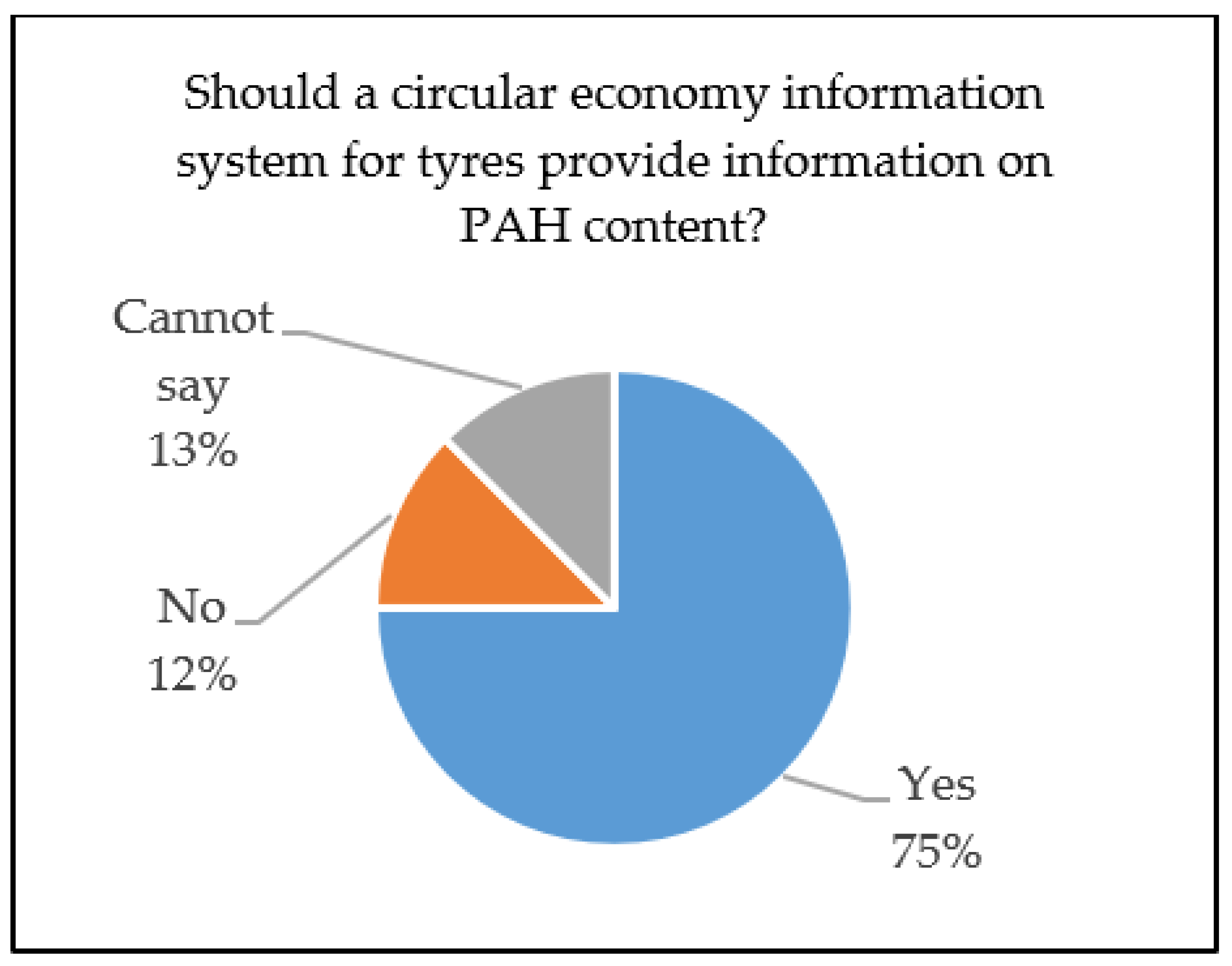Creating a Circular Economy in the Automotive Industry: The Contribution of Combining Crowdsourcing and Delphi Research
Abstract
:1. Introduction
1.1. Supporting the Development of a Circular Economy by Crowdsourcing and Delphi Research
- 1.
- Which input (information on preferences and recommendations) can sustainability-oriented consumers and value system participants such as manufacturers and recyclers provide for specifying sustainable tyres, promoting their acceptance, and creating software for their configuration?
- 2.
- Which specific input for creating tyre-based CE products can be gained by crowdsourcing?
- 3.
- Which benefit can be gained by combining crowdsourcing and the Delphi methodology in this context?
1.2. The Intended CE
1.3. Technical and Societal Framework Conditions of the Intended CE Products in the EU
1.3.1. Tyre Characteristics
1.3.2. Social Life Cycle Aspects
1.3.3. Labelling
2. Materials and Methods
2.1. Methods to Analyse Preferences Regarding This CE
2.1.1. Delphi Method
2.1.2. Crowdsourcing
2.1.3. Combining Delphi Survey and Crowdsourcing Techniques
2.2. The Survey in Detail
2.2.1. Consumer Survey
2.2.2. Survey among Value System Participants
3. Results
3.1. Fundamental Stakeholder View: Benefits of a Software-Supported Tyre CE
3.2. Consumers’ and Value System Participants’ Input to Specify Sustainable CE Tyres and Tyre Configuration Software
‘PAH content (which is bound in [tyre] carbon black) [is important]. [It] prevents the marketing of new products made from old mature granules.’
3.3. Specific Information Gained by Crowdsourcing
3.4. Specific Information Gained by the Combination of Delphi and Crowdsourcing Techniques
4. Discussion
4.1. Summary of Findings
- Which input (information on preferences and recommendations) can sustainability-oriented consumers and value system participants such as manufacturers and recyclers provide for specifying sustainable tyres, promoting their acceptance, and creating software for their configuration?
- Which specific input for creating tyre-based CE products can be gained by crowdsourcing?
- Which benefit can be gained by combining crowdsourcing and the Delphi methodology in this context?
4.2. Limitations
5. Conclusions
5.1. Implications for Stakeholder Analyses by Researchers and Managers
- Which analytical methods shall be used to determine the PAH content?
- Which limit values shall be set?
- Who shall provide the label?
- How can the acceptance of a potential label and its usability also be ensured for public procurement?
5.2. Implications for the Further Development of a Tyre CE
- Promote the development of test procedures for the wear and mileage of tyres
- Stimulate CE tyre labelling and certification
- Promote tyres with low PAH content
Funding
Institutional Review Board Statement
Informed Consent Statement
Data Availability Statement
Conflicts of Interest
Appendix A
| Consumers | Value System Participants | |
|---|---|---|
| Round 1 | ||
| Questions on the participants |
|
|
| Topics for both target groups |
| |
| Individual topics for each target group |
|
|
| Round 2 | ||
| Questions on the participants |
|
|
| Individual topics for each target group |
|
|
| Topics for both groups |
| |
References
- European Commission. Circular Economy. 2015. Available online: https://ec.europa.eu/growth/industry/sustainability/circular-economy_en (accessed on 5 May 2020).
- Okoli, C.; Pawlowski, S.D. The Delphi method as a research tool: An example, design considerations and applications. Inf. Manag. 2004, 42, 15–29. [Google Scholar] [CrossRef] [Green Version]
- De Jesus, A.; Antunes, P.; Santos, R.; Mendonça, S. Eco-innovation pathways to a circular economy: Envisioning priorities through a Delphi approach. J. Clean. Prod. 2019, 228, 1494–1513. [Google Scholar] [CrossRef]
- Turoff, M.; Linstone, H.A. The Delphi Method: Techniques and Applications; Linstone, H., Turoff, M., Eds.; online version 2002. Available online: https://web.njit.edu/~turoff/pubs/delphibook/delphibook.pdf (accessed on 5 May 2020).
- Flostrand, A. Finding the future: Crowdsourcing versus the Delphi technique. Bus. Horiz. 2017, 60, 229–236. [Google Scholar] [CrossRef]
- Mmereki, D.; Machola, B.; Mokokwe, K. Status of waste tires and management practice in Botswana. J. Air Waste Manag. Assoc. 2019, 69, 1230–1246. [Google Scholar] [CrossRef] [PubMed]
- Hiebel, M.; Bertling, J.; Nühlen, J.; Pflaum, H.; Somborn-Schulz, A.; Franke, M.; Reh, K.; Kroop, S. Studie zur Circular Economy im Hinblick auf die chemische Industrie: Studie im Auftrag des Verbands der Chemischen Industrie e.V., Landesverband NRW; Fraunhofer UMSICHT: Oberhausen, Germany, 2017; Available online: http://publica.fraunhofer.de/eprints/urn_nbn_de_0011-n-4769003.pdf (accessed on 15 October 2019).
- Grammelis, P.; Margaritis, N.; Dallas, P.; Rakopoulos, D.; Mavrias, G. A Review on Management of End of Life Tires (ELTs) and Alternative Uses of Textile Fibers. Energies 2021, 14, 571. [Google Scholar] [CrossRef]
- Konietzko, J.; Bocken, N.; Hultink, E.J. A Tool to Analyze, Ideate and Develop Circular Innovation Ecosystems. Sustainability 2020, 12, 417. [Google Scholar] [CrossRef] [Green Version]
- Dyckhoff, H.; Keilen, J.; Souren, R. Konzeptionelle Grundlagen kreislaufgerechter Produktinnovationen in der Automobilindustrie. In Nachhaltiges Innovationsmanagement; Schwarz, E.J., Ed.; Gabler: Wiesbaden, Germany, 2004; pp. 361–380. [Google Scholar]
- OECD. OECD Statistics Working Papers, 2008/01. 2018. Available online: https://www.oecd-ilibrary.org/economics/defining-entrepreneurial-activity_243164686763 (accessed on 5 May 2020).
- Schumpeter, J.A. The theory of economic development: An inquiry into profits, capital, credit, interest, and the business cycle. In Harvard Economic Studies; Harvard University Press: Cambridge, UK, 1934; Volume XLVI. [Google Scholar]
- European Parliament and the Council. Directive 2008/98/EC of the European Parliament and of the Council of 19 November 2008 on Waste and Repealing Certain Directives (Text with EEA Relevance). 2008. Available online: http://data.europa.eu/eli/dir/2008/98/oj (accessed on 5 July 2018).
- European Parliament and the Council. Regulation (EC) No 1907/2006 of the European Parliament and of the Council of 18 December 2006 Concerning the Registration, Evaluation, Authorisation and Restriction of Chemicals (REACH), Establishing a European Chemicals Agency, Amending Directive 1999/45/EC and Repealing Council Regulation (EEC) No 793/93 and Commission Regulation (EC) No 1488/94 as well as Council Directive 76/769/EEC and Commission Directives 91/155/EEC, 93/67/EEC, 93/105/EC and 2000/21/EC (Text with EEA Relevance). 2006. Available online: http://data.europa.eu/eli/reg/2006/1907/2014-04-10 (accessed on 15 February 2021).
- European Parliament and the Council. Regulation (EC) No 1272/2008 of the European Parliament and of the Council of 16 December 2008 on Classification, Labelling and Packaging of Substances and Mixtures, Amending and Repealing Directives 67/548/EEC and 1999/45/EC, and Amending Regulation (EC) No 1907/2006 (Text with EEA Relevance). 2008. Available online: http://data.europa.eu/eli/reg/2008/1272/oj (accessed on 10 May 2021).
- European Commission. Commission Regulation (EU) No 1272/2013 of 6 December 2013 Amending Annex XVII to Regulation (EC) No 1907/2006 of the European Parliament and of the Council on the Registration, Evaluation, Authorisation and Re-striction of Chemicals (REACH) as Regards Polycyclic Aromatic Hydrocarbons (Text with EEA Relevance). 2013. Available online: http://data.europa.eu/eli/reg/2013/1272/oj (accessed on 27 November 2019).
- European Commission. Commission Regulation (EU) 2018/1513 of 10 October 2018 amending Annex XVII to Regulation (EC) No 1907/2006 of the European Parliament and of the Council concerning the Registration, Evaluation, Authorisation and Restriction of Chemicals (REACH) As Regards Certain Substances Classified as Carcinogenic, Mutagenic or Toxic for Reproduction (CMR), Category 1a or 1b (Text with EEA Relevance). 2018. Available online: http://data.europa.eu/eli/reg/2018/1513/oj (accessed on 15 October 2018).
- Bundesumweltamt. Hintergrund // Januar 2016. Polyzyklische Aromatische Kohlenwasserstoffe Umweltschädlich! Giftig! Unvermeidbar? 2016. Available online: https://www.umweltbundesamt.de/sites/default/files/medien/376/publikationen/polyzyklische_aromatische_kohlenwasserstoffe.pdf (accessed on 27 November 2019).
- Bundesinstitut für Risikobewertung. PAK in Verbrauchernahen Produkten Müssen so Weit wie Möglich Minimiert Werden, Aktualisierte Stellungnahme Nr. 025/2009 des BfR vom 8. Juni 2009. Available online: https://mobil.bfr.bund.de/cm/343/pak_in_verbrauchernahen_produkten_muessen_so_weit_wie_moeglich_minimiert_werden.pdf (accessed on 27 November 2019).
- Kühnen, M.; Hahn, R. Indicators in Social Life Cycle Assessment: A Review of Frameworks, Theories, and Empirical Experience. J. Ind. Ecol. 2017, 21, 1547–1565. [Google Scholar] [CrossRef] [Green Version]
- Mitchell, R.K.; Agle, B.R.; Wood, D.J. Toward a Theory of Stakeholder Identification and Salience: Defining the Principle of who and What Really Counts. Acad. Manag. Rev. 1997, 22, 853–886. [Google Scholar] [CrossRef]
- International Organization for Standardization. Traditional Chinese Medicine—Labelling Requirements of Products Intended for Oral or Topical Use; ISO: Geneva, Switzerland, 2018; ISO 21371:2018. [Google Scholar]
- Rubik, F. Product Policy and the Environment: The Example of Eco-Labels. Schriftenreihe des IÖW 88/95; IÖW: Berlin/Heidelberg, Germany, 1995. [Google Scholar]
- Moore, B.; Wentz, M. Chapter 10. Eco-labeling for textiles and apparel. In Sustainable Textiles. Life Cycle and Environmental Impact; Blackburn, R.S., Ed.; Woodhead: Cambridge, UK, 2009. [Google Scholar]
- Galarraga-Gallastegui, I. The use of eco-labels: A review of the literature. Environ. Policy Gov. 2002, 2002, 316–331. [Google Scholar] [CrossRef]
- European Commission. Tyres Energy Labelling Requirements Apply to This Product. 2021. Available online: https://ec.europa.eu/info/energy-climate-change-environment/standards-tools-and-labels/products-labelling-rules-and-requirements/energy-label-and-ecodesign/energy-efficient-products/tyres_en (accessed on 26 April 2021).
- Linstone, H.A.; Turoff, M. The Delphi Method: Techniques and Applications; Addison-Wesley Publishing Company: Boston, MA, USA, 1975. [Google Scholar]
- Turoff, M.; Hiltz, S.R.; Li, Z.; Wang, Y.; Cho, H.-K.; Xiang, Y. Online Collaborative Learning Enhancement Through the Delphi Method. 2004. Available online: https://web.njit.edu/~turoff/Papers/ozchi2004.htm (accessed on 5 May 2020).
- Paré, G.; Cameron, A.-F.; Poba-Nzaou, P.; Templier, M. A systematic assessment of rigor in information systems ranking-type Delphi studies. Inf. Manag. 2013, 50, 207–217. [Google Scholar] [CrossRef]
- Kobus, J.; Westner, M. Ranking-type delphi studies in IS research: Step-by-step guide and analytical extension. In Proceedings of the IADIS International Conference on Information Systems, Vilamoura, Algarve, Portugal, 9–11 April 2016. [Google Scholar]
- Grime, M.M.; Wright, G. Delphi Method. In Wiley StatsRef: Statistics Reference Online; Balakrishnan, N., Colton, T., Everitt, B., Piegorsch, W., Ruggeriund, F., Teugels, J., Eds.; John Wiley & Sons: Chichester, UK, 2014; pp. 1–6. [Google Scholar]
- Surowiecki, J. The Wisdom of Crowds, 1st ed.; Anchor Books: New York, NY, USA, 2005. [Google Scholar]
- Howe, J. The rise of crowdsourcing. Wired Mag. 2006, 14, 1–6. [Google Scholar]
- Schenk, E.; Guittard, C. Towards a characterization of crowdsourcing practices. J. Innov. Econ. Manag. 2011, 7, 93–107. [Google Scholar] [CrossRef] [Green Version]
- Kietzmann, J. Crowdsourcing: A revised definition and an introduction to new research. Bus. Horiz. 2017, 60, 151–153. [Google Scholar] [CrossRef]
- Prpić, J.; Shukla, P.P.; Kietzmann, J.H.; McCarthy, I.P. How to work a crowd: Developing crowd capital through crowdsourcing. Bus. Horiz. 2015, 58, 77–85. [Google Scholar] [CrossRef] [Green Version]
- Lüdeke-Freund, F.; Gold, S.; Bocken, N.M.P. A Review and Typology of Circular Economy Business Model Patterns. J. Ind. Ecol. 2018, 23, 36–61. [Google Scholar] [CrossRef] [Green Version]
- Li, T.; McCluskey, J.J. Consumer preferences for second-generation bioethanol. Energy Econ. 2017, 61, 1–7. [Google Scholar] [CrossRef] [Green Version]
- Kraftfahrt-Bundesamt. Fahrzeugzulassungen (FZ): Bestand an Kraftfahrzeugen und Kraftfahrzeuganhängern nach Haltern, Wirtschaftszweigen 1. January 2019 FZ 23. 2019. Available online: https://www.kba.de/SharedDocs/Publikationen/DE/Statistik/Fahrzeuge/FZ/2019/fz23_2019_pdf.pdf?__blob=publicationFile&v=7 (accessed on 5 May 2020).
- De Bellis, E.; Hildebrand, C.; Ito, K.; Herrmann, A.; Schmitt, B. Personalizing the Customization Experience: A Matching Theory of Mass Customization Interfaces and Cultural Information Processing. J. Mark. Res. 2019, 56, 1050–1065. [Google Scholar] [CrossRef]
- Geert Hofstede; Universities of Maastricht and Tilburg. The Netherlands Dimensionalizing Cultures: The Hofstede Model in Context. Online Read. Psychol. Cult. 2011, 2, 8. [Google Scholar] [CrossRef]
- Hofstede, G.; Hofstede, G.J.; Minkov, M. Cultures and Organizations: Software of the Mind: Intercultural Cooperation and Its Importance for Survival, 3rd ed.; McGraw-Hill: New York, NY, USA, 2010. [Google Scholar]
- Halder, P.; Hansen, E.N.; Kangas, J.; Laukkanen, T. How national culture and ethics matter in consumers’ green consumption values. J. Clean. Prod. 2020, 265, 121754. [Google Scholar] [CrossRef]
- Vuong, Q.H.; Napier, N.K. Acculturation and global mindsponge: An emerging market perspective. Int. J. Intercult. Relat. 2015, 49, 354–367. [Google Scholar] [CrossRef]
- European Parliament and the Council of the European Union (2020) Regulation (EU) 2020/740 of the European Parliament and the Council of 25 May 2020 on the labelling of tyres with respect to fuel efficiency and other parameters, amending Regulation (EU) 2017/1369 and repealing Regulation (EC) No 1222/2009. Official Journal of the European Union. Available online: https://eur-lex.europa.eu/legal-content/EN/TXT/?uri=CELEX%3A32020R0740(accessed on 5 May 2020).
- European Commission (2020) Communication from the Commission to the European Parliament, the Council, the European Economic and Social Committee and the Committee of the Regions. A new Circular Economy Action Plan: For a cleaner and more competitive Europe. COM(2020) 98 Final. Available online: https://eur-lex.europa.eu/legal-content/EN/TXT/HTML/?uri=CELEX:52020DC0098&from=EN (accessed on 5 May 2020).













| Common Features of Crowdsourcing and Delphi Methods According to [5] | Application in This Study | Explanation | |
|---|---|---|---|
| Participants are anonymous to one another | ✓ | Anonymous online survey | |
| Incentive to participate is offered in some form | ✓ | Use of a raffle | |
| Impartiality and objectivity | ✓ | Participants of member organisations could not participate | |
| Neither have checks for reliability | Modified | Surveying different target groups provides certain reliability; an appropriate sampling was used | |
| Differences between crowdsourcing and Delphi methods according to [5] | Application in this study | Explanation | |
| Delphi (D) | Crowdsourcing (C) | ||
| Relies on experts with explicit knowledge | Relies on non-expert laypeople | D + C | Experts and laypeople were involved |
| A smaller group of experts | Open to typically huge groups | C | A large group of >500 people participated |
| Multiple rounds of estimation, with feedback to the experts between rounds | Single round of estimation, no feedback | D | Two rounds |
| Results of the study are of interest to participants | Results might or might not be of interest to participants | D + C | Both scenarios are possible. The products shall, however, meet the participants’ specific needs. Participants of the second round expressed their interest in this activity specifically in the first round |
| High-quality data | Highly variable data quality | D | The consumers are sustainability-conscious consumers and loyal to the activities of their platform. Several test questions were included for quality improvements |
| Low non-response rate | Self-selected | D + C | Mainly open survey, self-selection by consumers of a sustainability platform |
| Participants not anonymous to the researcher | Participants are generally anonymous to the researcher | C | Anonymous online survey |
| Participants cannot be competitors | Participants are the general public | Modified | Due to the anonymous process, value system players may also be competitors; volunteer sampling was used for consumers of a sustainability platform |
| Duration at least 3–5 days | Open-ended | Modified | Several weeks |
| Consumers | Value System Participants |
|---|---|
451 persons, of which 261 have been involved in tyre purchases and were involved in the analysis. Age in years and share (linked by arrows):
| 58 value system representatives coming from:
|
| Age (Years) | Share ConCirMy Survey | Age (Years) | Share Car Owners Germany * |
|---|---|---|---|
| 20–29 | 3% | 21–29 | 7% |
| 30–39 | 18% | 30–39 | 14% |
| 40–49 | 18% | 40–49 | 29% |
| 50–59 | 32% | 50–59 | 29% |
| 60–69 | 20% | 60–69 | 20% |
| 70–79 | 9% | 70–79 | 11% |
| Faster coordination of the partners involved & uniform procedures | Savings in the disposal & recycling or storage of used tyres | Transparent information flow & quality without loss of details | |
| Shorter transport routes & demand-oriented production control | Minimum mileage guarantee | Lower material costs | Probably improved coordination of withdrawal procedures |
| Better availability of information | Better recycling possibilities due to high return rates | Big Data & benefits of its use | |
| Topic | View of the Sustainability-Oriented Consumers | View of the Value System Participants |
|---|---|---|
| Top 10 sustainability characteristics of tyres (for a tyre configuration in the consumer study) | First round
| First round
|
| Interest in specific sustainable tyres and additional products (consumers only) | First round
| |
| Interest in a quality label for sustainable tyres | First round
| First round
|
| Collaboration and configuration software | First round
| First round
|
Publisher’s Note: MDPI stays neutral with regard to jurisdictional claims in published maps and institutional affiliations. |
© 2021 by the author. Licensee MDPI, Basel, Switzerland. This article is an open access article distributed under the terms and conditions of the Creative Commons Attribution (CC BY) license (https://creativecommons.org/licenses/by/4.0/).
Share and Cite
Wurster, S. Creating a Circular Economy in the Automotive Industry: The Contribution of Combining Crowdsourcing and Delphi Research. Sustainability 2021, 13, 6762. https://doi.org/10.3390/su13126762
Wurster S. Creating a Circular Economy in the Automotive Industry: The Contribution of Combining Crowdsourcing and Delphi Research. Sustainability. 2021; 13(12):6762. https://doi.org/10.3390/su13126762
Chicago/Turabian StyleWurster, Simone. 2021. "Creating a Circular Economy in the Automotive Industry: The Contribution of Combining Crowdsourcing and Delphi Research" Sustainability 13, no. 12: 6762. https://doi.org/10.3390/su13126762
APA StyleWurster, S. (2021). Creating a Circular Economy in the Automotive Industry: The Contribution of Combining Crowdsourcing and Delphi Research. Sustainability, 13(12), 6762. https://doi.org/10.3390/su13126762





